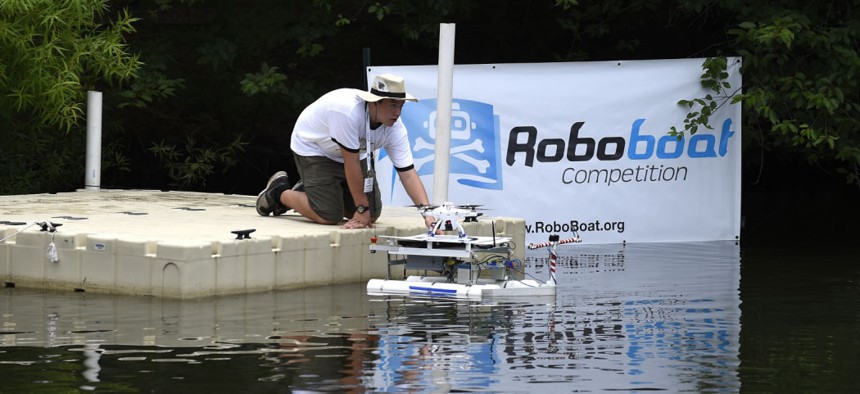
RoboBoats navigate the next stage in autonomous operations
The teams in ONR’s annual competition tackle real-world maritime challenges without human operators at the controls.
While the Navy is working on several fronts to develop autonomous watercraft to support future missions, it also has an eye on developing the next generation of engineers capable of putting autonomous craft in play. Those two efforts came together, again, recently in the Office of Naval Research’s annual RoboBoat Competition in Virginia Beach, Va.
The year’s RoboBoat, the ninth such competition, featured 13 teams required to out their autonomous surface vehicles through a specific set of tasks designed to mirror real-world maritime operations. The competition is co-sponsored by the Association for Unmanned Vehicle Systems International Foundation.
Two mandatory tasks were intended to show off a boat’s propulsion, speed, navigation and basic sensing abilities, ONR said in a release. Those were coupled with mission tasks that included avoiding obstacles in the water, docking, acoustic beam positioning, the launch, recover and communication with an autonomous underwater vessel, and the ability to return to dock. All of the tasks had to be performed fully autonomously, without human control.
“Every challenge in the competition is designed to mimic real-life maritime missions,” Kelly Cooper, a program officer in ONR’s Sea Warfare and Weapons Department, Ship Systems and Engineering Research Division, said in the release. “This competition really tests the engineering design and autonomous capabilities of the boat—as well as helps these students develop the engineering skills needed to be successful in a possible future in the naval research community.”
The teams this year, as in years past, came mostly from U.S. universities, with additional entrants from Asia. The Georgia Institute of Technology took the first place prize of $10,000. Florida Atlantic University won $4,000 in second place, followed by the Institut Teknologi Sepuluh Nopember in Indonesia ($2,500), and the Daytona Beach Homeschoolers ($1,500). The University of Ulsan in Korea, the Institut Teknologi Sepuluh Nopember and Georgia Institute of Technology also won additional prizes of $1,000 or $500 in special categories.
The prize money is nice, but the biggest factor for ONR is pushing the ball forward on autonomous operations, some the Navy has put a high priority on. Other projects developing an autonomous fleet include the drop-in CARACaS sensor and software kit that can turn surface boats into swarming autonomous vessels, a recently christened sub-hunting surface ship underwater drones. And because the Navy also operates in the air, it’s also exploring an number of airborne options, such as the small, swarming drones being developed under its LOCUST program.
“As the science behind autonomous and unmanned systems continues to improve, you will begin to see more autonomous missions which free sailors and Marines for other tasks and protects them from some of their dangerous duties,” Cooper said. “It’s important that students participating in programs like RoboBoat know that they are a part of that process—they are fostering innovation through competition for the next generation of these types of naval systems.”
Other participants in this year’s RoboBoat were Embry-Riddle Aeronautical University, Old Dominion University, SRM University in Korea, the U.S. Naval Academy, Universitas Indonesia, University of Michigan and the University of West Florida.